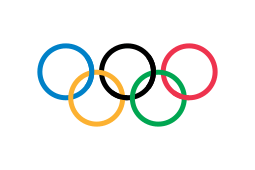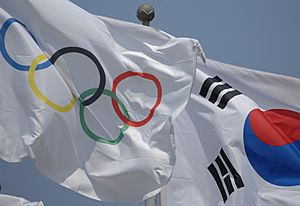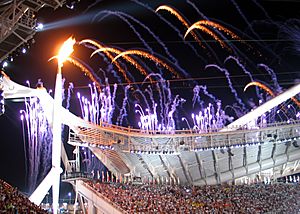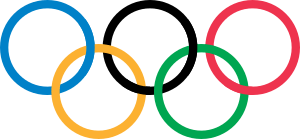Olympic symbols facts for kids
The Olympic symbols are special icons, flags, and signs used by the International Olympic Committee (IOC) to celebrate the Olympic Games. Some symbols, like the Olympic flame, music, and special themes, are mostly seen during the Games. Others, like the flags, are used all year round. The Olympic flag was designed by Baron de Coubertin in 1913. It was first flown in 1920 in Antwerp, Belgium, during the 1920 Summer Olympics. The five rings on the flag stand for the five continents of the world.
Contents
Olympic Motto and Creed
The Olympic motto is Citius, Altius, Fortius. This is Latin for "faster, higher, stronger." Pierre de Coubertin suggested this motto when the International Olympic Committee was created in 1894. He got the idea from his friend Henri Didon, a priest who loved sports. Coubertin felt these words showed the beauty and spirit of sports. The motto was first used at the 1924 Paris Olympic Games.
Coubertin's ideas about the Olympics are also found in the Olympic creed:
The most important thing in the Olympic Games is not to win but to take part, just as the most important thing in life is not the triumph but the struggle. The essential thing is not to have conquered but to have fought well.
Coubertin found this text in a speech by a bishop named Ethelbert Talbot during the 1908 London Games.
The Olympic Rings
The Olympic rings are five circles linked together. They are colored blue, yellow, black, green, and red on a white background. Pierre de Coubertin created this symbol in 1913. He wanted the rings to represent the five continents: Europe, Africa, Asia, America, and Oceania.
Coubertin also said that the colors of the rings, along with the white background, included the colors of every country's flag competing at that time. He wrote in 1913:
...the six colors [including the flag's white background] combined in this way reproduce the colors of every country without exception. This, truly, is an international emblem.
The idea for the linked rings might have come from the USFSA, a French sports group Coubertin was involved with. Their emblem had two linked rings. A Swiss psychiatrist named Carl Jung also used the idea of rings to symbolize continuity and human connection.
The 1914 Olympic Congress was stopped because World War I began. But the Olympic rings symbol and flag were officially used later. They first appeared at the 1920 Summer Olympics in Antwerp, Belgium.
The symbol became very popular before the 1936 Summer Olympics in Berlin. Carl Diem, who organized the 1936 Games, wanted a torch relay ceremony at Delphi in Greece. He had the Olympic rings carved into a stone there. This led to a myth that the rings came from ancient Greece, but this is not true.
Today, the International Olympic Committee (IOC) says the symbol shows that the Olympic Movement is worldwide. It welcomes all countries to join. The Olympic symbol represents the joining of the "five continents" and athletes from all over the world meeting at the Olympic Games. The IOC has stated that no specific ring color stands for a particular continent.
Olympic Flags
 |
|
| Name | The Olympic rings |
|---|---|
| Use | Sport |
| Proportion | 2:3 |
| Adopted | 14 August 1920 |
| Design | Five interlaced rings of equal dimensions (the Olympic rings), used alone, in one or in five different colours. When used in its five-colour version, these colours shall be, from left to right, blue, yellow, black, green and red. The rings are interlaced from left to right; the blue, black and red rings are situated at the top, the yellow and green rings at the bottom in accordance with the following graphic reproduction. |
| Designed by | Pierre de Coubertin |
The main Olympic flag was created by Pierre de Coubertin in 1913. He described it as a "light, appealing flag" that would be a "delight to see fluttering in the wind." He believed its meaning was very symbolic and would be a great international emblem.
Specific Olympic Flags
There are special Olympic flags that are passed between cities that will host the next Olympic Games. During the closing ceremony of each Olympics, in what is called the Antwerp Ceremony, the flag is given from the mayor of one host city to the mayor of the next host city. This flag is then taken to the new host city and displayed at their city hall.
These flags are different from the very large Olympic flags made for each Games. Those big flags are flown over the main stadium and then put away. Because there isn't one specific design for these large flags, they often have small differences, like slight color changes or whether the rings have white outlines.
Antwerp Flag
The Olympic flag with the five rings was first raised at the 1920 Summer Olympics in Antwerp, Belgium. After those Games, the flag went missing. A new Olympic flag had to be made for the 1924 Summer Olympics in Paris. Even though it was a replacement, the IOC still calls it the "Antwerp Flag."
This flag was passed to the next host city for the Summer Olympic Games or Winter Olympic Games until the 1952 Winter Olympics in Oslo, Norway. After that, a separate flag was made just for the Winter Olympics. The 1924 flag continued to be used for the Summer Olympics until the 1988 Summer Olympics in Seoul, when it was retired.
In 1997, a former US Olympic athlete named Hal Haig Prieste revealed that he had taken the original Antwerp flag in 1920. He had kept it in his suitcase for 77 years! He returned the flag to the IOC in 2000. The original Antwerp Flag is now shown at the Olympic Museum in Lausanne, Switzerland.
Oslo Flag
The Oslo flag was given to the IOC by the mayor of Oslo, Norway, during the 1952 Winter Olympics. This flag was then passed to the next host city for the Winter Olympics until 2014. The real Oslo flag is now kept safely in a special box, and a copy is used during recent closing ceremonies.
Seoul Flag

The Seoul flag took over from the Antwerp Flag. It was given to the IOC at the 1988 Summer Olympics by the city of Seoul, South Korea. Since then, it has been passed to the next host city for the Summer Olympic Games. The Seoul flag is currently displayed in the Tokyo Metropolitan Government Building.
Rio de Janeiro Flag
The Rio de Janeiro flag followed the Seoul Flag. It was given to the IOC at the 2016 Summer Olympics by the city of Rio de Janeiro, Brazil. It has since been passed to the next host city for the Summer Olympic Games, which was Tokyo.
PyeongChang Flag
The PyeongChang flag took over from the Oslo Flag. It was given to the IOC at the 2018 Winter Olympics by the city of PyeongChang, South Korea. It has since been passed to the next host city for the Winter Olympic Games, which was Beijing.
Youth Olympic Games Flags
For the first Youth Olympic Games, a special Olympic flag was made for this junior version of the Games. This flag looks like the main Olympic flag but also has the host city and year on it. It was first given to Singapore by IOC President Jacques Rogge.
For the first winter Youth Olympic Games, an Olympic flag was given to the IOC at the 2012 Winter Youth Olympics by the city of Innsbruck, Austria. This flag has since been passed to the next host city for the Winter Youth Olympics.
Olympic Flame and Torch Relay

The tradition of moving the Olympic flame from Greece to the Olympic host city began with the Berlin Games in 1936. Months before the Games, the Olympic flame is lit on a torch. This happens using the sun's rays at the ancient Olympic site in Olympia, Greece.
The torch is then carried out of Greece, usually traveling around the country or continent where the Games will be held. Athletes, leaders, famous people, and everyday people carry the Olympic torch. Sometimes it travels in unusual ways, like being sent by satellite for the Montreal 1976 Games, going underwater without going out for Sydney 2000, or even going into space and to the North Pole for Sochi 2014.
On the last day of the torch relay, during the Opening Ceremony, the flame reaches the main stadium. It is used to light a large cauldron, which signals the start of the Games.
Olympic Medals and Diplomas
The Olympic medals given to winners are another important symbol. Medals are made of gold-plated silver (for gold medals), silver, or bronze. They are given to the top three athletes in each event.
From 1928 to 2000, the front side of the medals showed Nike, the Greek goddess of victory. She held a palm branch and a winner's crown. This design was created by Giuseppe Cassioli. The back side of the medals, and the words for each Olympics, changed to show the host city.
In 2004, the front of the medals changed to show more of Greece's history. This new design showed the goddess Nike flying into the Panathenaic stadium, showing the Games' return. This design was by Greek jewelry designer Elena Votsi.
Olympic diplomas are given to athletes who finish in fourth, fifth, and sixth place since 1949. Since 1981, they are also given to those who finish seventh and eighth.
Olympic Anthems
The "Olympic Hymn" is the official song played when the Olympic flag is raised. It was composed by Spyridon Samaras with words from a poem by the Greek poet Kostis Palamas. This anthem was first performed at the opening ceremony of the 1896 Athens Olympic Games. However, it wasn't made the official hymn by the IOC until 1958.
Other famous Olympic songs and fanfares include:
- "Bugler's Dream": This music, written by Leo Arnaud in 1958, is often thought of as the "Olympic Theme" in America. It has been used in TV coverage of the Olympics since 1964.
- "Olympic Fanfare and Theme": Composed by John Williams for the Los Angeles 1984 Summer Olympics. This powerful piece is very well-known and has won awards. It was also used in the closing ceremony of the 2010 Winter Olympics.
- "Summon the Heroes": Another theme written by John Williams for the 1996 Summer Olympics in Atlanta.
- "Call of the Champions": This theme was also written by John Williams for the 2002 Salt Lake Winter Olympics.
Many other composers have also created music for the Olympics.
The Kotinos (Olive Wreath)
The kotinos (Greek: κότινος) is an olive branch twisted into a circle or horseshoe shape. In the ancient Olympic Games, there were no gold, silver, or bronze medals. The only winner in each event was crowned with an olive wreath. This wreath was made from wild olive leaves from a special tree near the temple of Zeus in Olympia.
The winning athletes were greatly honored and praised. Their achievements were recorded so future generations could remember them. The Greek writer Herodotus tells a story about the Persian king Xerxes asking why so few Greek men were defending Thermopylae. He was told, "All other men are participating in the Olympic Games." When Xerxes asked what the prize was, the answer was "An olive-wreath." One of his generals, Tigranes, then said, "Good heavens! Mardonius, what kind of men are these against whom you have brought us to fight? Men who do not compete for possessions, but for honour."
The tradition of the kotinos was brought back for the 2004 Summer Olympics in Athens. However, this time it was given along with the gold medal. The kotinos was also chosen as the emblem for the 2004 Games.
Olympic Salute

The Olympic salute is a way of greeting where the right arm and hand are stretched upward, with the palm facing out and down, and fingers touching. The arm is raised higher and angled to the right from the shoulder. This salute can be seen on official posters for the Paris 1924 and Berlin 1936 Games.
After World War II, the Olympic salute was used less often because it looked like the Nazi salute. The French team used it at the opening ceremony of the 1948 Winter Olympics. The Japanese team also used it in 1956.
Olympic Mascots
Since the 1968 Winter Olympics in Grenoble, France, the Olympic Games have had a mascot. A mascot is usually an animal from the area or sometimes a human figure that shows the local culture. The first major Olympic mascot was Misha at the 1980 Summer Olympics in Moscow. Misha was used a lot in the opening and closing ceremonies, had a cartoon, and appeared on many products. Today, many products for young people feature the mascots.
Protecting Olympic Symbols
The Olympic movement works hard to protect its symbols. Many countries have given the movement special rights to the five linked rings and the word "Olympic." This means others cannot use them without permission.
The Olympic movement has taken action against groups that used their symbols without permission. These include the Gay Games, a band called The Hopefuls, and the Redneck Olympics.
In 1938, a Norwegian company patented a label for its root beer that had the five Olympic rings. When Norway hosted the Winter Olympics in 1952, the Olympic Committee found out that this company owned the rights to the rings in Norway. Today, the company Ringnes AS still owns the right to use the rings on its root beer. A few other companies have also been allowed to use the Olympic name, like Olympic Paint and the former Greek airline Olympic Airlines.
Some other sports groups and events have been given permission by the IOC to use the word "Olympics" in their names. An example is the Special Olympics, a worldwide sports event for people with intellectual disabilities.
The IOC has full control over how Olympic Symbols are used. This is thanks to an international agreement called the Nairobi Treaty, signed by many countries in 1981. This treaty makes sure that Olympic Symbols are protected from being used for business without the IOC's permission. If the IOC allows a symbol to be used in a country that signed the treaty, that country's National Olympic Committee gets some of the money from that use.
In recent years, Olympic organizers have also asked for laws to stop "ambush marketing." This is when companies that are not official sponsors try to link themselves to the Games. These laws put strict limits on using any words or images that could suggest a connection to the Games, even just mentioning the host city or the year.
Images for kids
See also
 In Spanish: Símbolos olímpicos para niños
In Spanish: Símbolos olímpicos para niños






